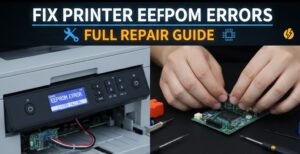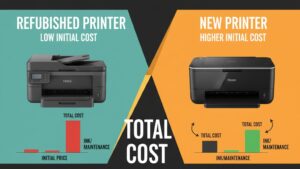Introduction
Extend printer lifespan strategies can transform a typical 3-year device into a reliable workhorse that serves you for 6-8 years or more. Most printers fail prematurely due to preventable issues like dust buildup, improper maintenance, and user neglect rather than actual wear.
Professional service technicians see the same problems repeatedly in “broken” printers that simple maintenance could have prevented. These issues cost consumers thousands in unnecessary replacements each year.
Smart printer care focuses on preventing problems before they start. Simple daily and weekly habits protect expensive components while maintaining optimal performance throughout your printer’s extended life.
The strategies you’ll discover today come directly from commercial print shops and IT departments that depend on maximum equipment longevity for profitability and productivity.
What Does It Mean to Extend Printer Lifespan?
Extending printer lifespan means maximizing your device’s useful life through strategic maintenance, proper usage, and preventive care. This approach focuses on protecting critical components that determine overall printer longevity.
Modern printers contain sophisticated mechanisms designed to last thousands of pages when properly maintained. However, poor care accelerates wear and causes premature failures that force expensive replacements.
Professional printer longevity strategies address the top causes of device failure: dust accumulation, ink system problems, mechanical wear, and software issues. Each area requires specific attention for optimal results.
The goal is maintaining like-new performance for years beyond typical expectations. Well-maintained printers often outlast their warranties by 200-300% while delivering consistent, high-quality output.
Successful lifespan extension requires understanding your printer’s specific needs and implementing appropriate care routines. Different printer types need different approaches for maximum longevity.
9 Powerful Strategies to Extend Printer Lifespan Dramatically

1. Implement Daily Dust Protection Protocols
Dust causes more printer failures than any other factor. Microscopic particles infiltrate mechanisms, clog air vents, and damage sensitive components over time.
Cover your printer with a dust-proof cover when not in use. Remove the cover completely during operation to prevent overheating and ensure proper ventilation.
Position printers away from high-traffic areas, air vents, and windows where dust accumulates quickly. Clean surrounding areas regularly to reduce airborne particles.
2. Master Proper Power Management Techniques
Correct power cycling extends electronic component life significantly. Never unplug printers during operation or while processing print jobs.
Use proper shutdown sequences through printer menus when available. This allows internal systems to complete maintenance cycles and protect print heads properly.
Install uninterruptible power supplies (UPS) for valuable printers. Power surges and outages cause expensive damage that proper protection prevents entirely.
3. Optimize Ink and Toner Usage Patterns
Strategic supply management prevents the most common causes of printer failure. Never allow ink cartridges to run completely empty before replacement.
Replace cartridges when they reach 10-15% capacity to prevent air bubbles and clogs. Empty cartridges damage print heads and cost more to repair than replacement cartridges cost.
Store spare supplies properly in cool, dry locations. Temperature extremes and humidity affect ink consistency and toner quality significantly.

4. Perfect Your Cleaning and Maintenance Schedule
Regular cleaning prevents buildup that causes mechanical failures. Establish weekly exterior cleaning routines using appropriate materials and techniques.
Clean paper feed mechanisms monthly with lint-free cloths and distilled water. Remove paper dust and debris that accumulates in rollers and guides.
Perform print head cleaning cycles when print quality degrades. Don’t wait for severe problems that require multiple cleaning attempts and waste expensive ink.
5. Choose Quality Paper and Supplies Consistently
Paper quality directly affects printer lifespan through dust generation, jamming frequency, and component wear. Invest in paper that meets manufacturer specifications exactly.
Avoid extremely cheap paper that sheds fibers and creates internal debris. The small savings disappear quickly when repair costs accumulate from damage.
Match paper weights and finishes to your printer’s capabilities. Using inappropriate materials stresses feed mechanisms and reduces component life.
6. Control Environmental Conditions Strategically
Temperature and humidity fluctuations stress printer components and accelerate wear. Maintain stable conditions between 60-75°F with 30-50% humidity when possible.
Avoid locations near heating vents, air conditioners, or direct sunlight that create temperature swings. Gradual changes are less harmful than sudden variations.
Provide adequate ventilation around all printer vents. Blocked airflow causes overheating that damages electronic components permanently.

7. Update Firmware and Software Religiously
Current firmware protects printers from known issues and optimizes performance for longevity. Check manufacturer websites monthly for updates.
Enable automatic updates when available to ensure continuous protection. Updated software fixes bugs that cause premature wear and component failures.
Document firmware versions and update dates for warranty and troubleshooting purposes. This information helps service technicians diagnose problems quickly.
8. Practice Smart Usage Patterns
Moderate, consistent usage extends printer lifespan better than sporadic heavy use or long idle periods. Print at least one page weekly to keep mechanisms lubricated.
Avoid maximum capacity print jobs that stress components unnecessarily. Break large jobs into smaller batches with cooling periods between runs.
Use appropriate quality settings for each task. Draft mode reduces wear for internal documents while high-quality settings should be reserved for important output.
9. Establish Professional Service Schedules
Annual professional maintenance catches problems before they cause major damage. Trained technicians access internal components that users cannot reach safely.
Professional cleaning removes accumulated debris and replaces worn consumable parts like rollers and filters. This service typically pays for itself through extended equipment life.
Keep maintenance records for warranty purposes and troubleshooting reference. Documented care often qualifies for extended warranty coverage.
Advanced Tools and Techniques for Maximum Printer Longevity
Specialized maintenance tools provide better results than improvised solutions. Lint-free cloths prevent scratching while compressed air removes debris from inaccessible areas safely.
Print head cleaning solutions designed for your specific printer type work better than generic alternatives. These formulations dissolve clogs without damaging delicate components.
Environmental monitoring tools track temperature and humidity conditions that affect printer performance. Simple gauges help maintain optimal conditions for equipment longevity.
Professional-grade surge protectors offer better protection than basic power strips. Look for models with equipment protection warranties that cover replacement costs.
Maintenance tracking software helps schedule routine care and monitor usage patterns. These programs remind users when service is due and track supply replacement intervals.
Critical Mistakes That Shorten Printer Lifespan
The biggest mistake users make is ignoring maintenance until problems appear. Reactive repairs cost significantly more than preventive care and often require replacing multiple damaged components.
Using incompatible supplies saves money initially but causes expensive damage over time. Generic cartridges and cheap paper often fail quality standards that protect printer mechanisms.
Forcing paper through jammed mechanisms damages feed systems permanently. Always follow proper jam clearing procedures and address underlying causes of frequent jams.
Ignoring environmental factors accelerates wear and reduces reliability. Dusty, humid, or temperature-extreme locations cause problems that proper placement prevents entirely.
Many users disable power management features to save time, not realizing these systems protect expensive components during idle periods. Proper shutdown sequences prevent damage.
Postponing firmware updates leaves printers vulnerable to known issues that manufacturers have already solved. Current software provides optimal protection and performance.
Overloading printers beyond rated capacities causes mechanical stress and premature failures. Respect duty cycle limits and provide adequate rest periods for heavy usage.
Frequently Asked Questions About Extending Printer Lifespan
How much can proper maintenance extend my printer’s life? Well-maintained printers typically last 2-3 times longer than neglected devices. A printer expected to last 3 years can easily serve 6-8 years with proper care and maintenance routines.
Is professional maintenance worth the cost for home printers? For printers worth over $300, annual professional service typically pays for itself through extended life and prevented repairs. Less expensive printers may not justify service costs.
What’s the most important factor for printer longevity? Dust protection provides the biggest impact for most users. Simple dust covers and proper placement prevent more failures than any other single factor.
Can I extend an old printer’s life if I start maintenance now? Yes, starting proper maintenance at any point helps, though earlier intervention provides better results. Even neglected printers benefit from professional cleaning and care.
Conclusion
These proven strategies to extend printer lifespan can double or triple your device’s useful life while maintaining optimal performance throughout its extended service. Simple daily habits and systematic maintenance prevent the problems that force premature replacements.
The key to successful printer longevity lies in consistent preventive care rather than reactive repairs. Small investments in maintenance tools, quality supplies, and professional service pay enormous dividends through extended equipment life.
Start implementing these techniques immediately to begin protecting your printer investment. Whether your device is new or several years old, proper care from this point forward will significantly extend its remaining useful life.
Remember that extending printer lifespan benefits both your budget and the environment by reducing electronic waste and maximizing the value of your technology investments.
Printer Setup Secrets: Ultimate Guide for Lightning-Fast Installation Read More.




